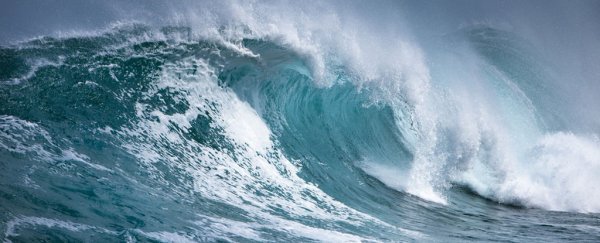The United Nations has announced a giant, record-breaking wave, with buoy data registering a towering wall of water reaching a stunning 19 metres (62.3 feet) in height.
For a bit of context, that's higher than a six-storey building, and even taller than four double-decker buses, if you stacked them one on top of the other.
The World Meteorological Organisation (WMO) announced this week that the epic wave was recorded by an automated buoy in the North Atlantic ocean between Iceland and the UK in February 2013, and now scientists can finally confirm its size.
"This is the first time we have ever measured a wave of 19 metres," says WMO Assistant Secretary-General Wenjian Zhang. "It is a remarkable record."
Scientists from the WMO's climatology extremes committee have classified the wave as "the highest significant wave height as measured by a buoy".
They say the phenomenon was due to a very strong cold front, which produced winds of up to 43.8 knots (81.1 km/hr, 50.4 mph) in the area.
Those conditions saw the 2013 wave overtake the previous record-holder from December 2007, which measured 18.275 metres (59.96 feet), and also occurred in the North Atlantic.
These monster waves are more common in the North Atlantic due to wind circulation patterns and atmospheric pressure in the northern hemisphere winter, which can produce intense extra-tropical storms sometimes described as weather 'bombs'.
These bombs tend to go off in the upper reaches of the North Atlantic, extending from the east of the Canadian coast up to the waters south of Iceland, and bordered by the west coast of the UK.
As this part of the Atlantic plays host to several commercial shipping routes, buoy measurements remain crucial for monitoring wave activity that's not picked up by human and satellite observations.
For measurement purposes, wave height is determined by the vertical distance from the crest of one wave to the trough of the next.
"Significant wave height", per the new world record, is an average figure, taken from the highest one-third of waves measured by an instrument in a 17.5-minute window.
But while this newly crowned 19-metre monster is now the world record for highest wave measured by a buoy, there's a separate category for wave height based on measurements taken from a ship.
And the record-holder for that category is even taller: a wave that stood a terrifying 29.05 metres (95.03 feet), as detected by the British oceanographic research vessel RRS Discovery in 2000. And again, the wave occurred in the North Atlantic.
But even that pales compared to numerous accounts of even bigger 'rogue' waves, including a wave in Alaska's Lituya Bay in 1958 estimated to have been 30.5 metres (100 feet) high.
The trouble with recognising such measurements is that they don't provide the same accuracy and precisison as buoy-based data.
"There have been many less reliable estimates of rogue waves from other platforms, and from satellite radar," wave expert Val Swail from Environment Canada told Doyle Rice at USA Today.
"These are generally unverifiable, since there is no ground truth for the satellite, and the others tend to be from pitching and rolling platforms such as ships."
In terms of waves recognised by the WMO, the records are viewable in the WMO's World Weather & Climate Extremes Archive, which details all kinds of meteorological outliers in temperatures, rainfall, hail, lightning, and lots more.
In other words, it's kind of like the Guinness World Records, but with absolutely nothing on pie-eating contests, long fingernails, or people holding their breath.
The new wave entry in the WMO Archive is listed here.
